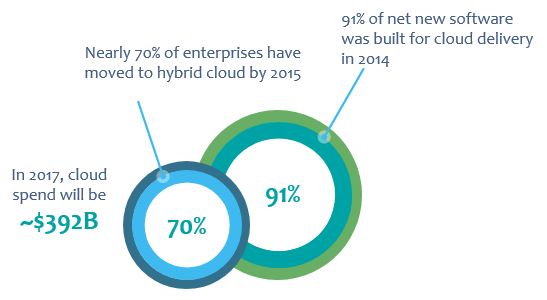One of the biggest trends in the IT industry at the moment is enterprise adoption of the public cloud. It’s obvious that it’s been accelerating over the recent years, but perhaps more importantly, Federal agencies are beginning to take a serious look at the cloud in an effort to reform IT and to achieve greater agility and operational efficiencies. In fact, according to recent data by various integrators and tech companies, U.S. government agencies are moving to the cloud and away from their own in-house data centers faster than private corporations.
According to Gartner and IDC, if you look at the capital expenditures, approximately $392 billion in total IT spend on the cloud will take place in 2017. That’s a massive number, and Federal agencies are starting to represent a big proportion of that:
One of the big reasons we are seeing so much momentum is due to the Federal Government’s “cloud‑first philosophy”, which was first described by former Federal CIO Vivek Kundra as an important aspect of government in order to remove so-called “inefficiencies” in the way IT is currently delivered.

The Office of Management and Budget (OMB) further refined it into a 25‑point plan to reform federal information technology. Essentially what the cloud‑first philosophy states is that if a federal agency is going to be rolling out a new application, they are required to stage it in the cloud first before they determine that the cloud doesn’t meet their needs. The overarching driver here is to reduce overall IT infrastructure costs and assist Federal agencies in the rapid deployment of new applications.
[pullquote] …inefficiencies negatively impact the Federal Government’s ability to serve the American public
— Vivek Kundra[/pullquote]
Although Cloud First was announced in February 2011, it wasn’t until 2015 that things really picked up, mostly due to ‘pre-qualified’ cloud offerings by the likes of cloud giants Amazon and Microsoft, with appropriate contract vehicles in place and embedded security offerings in order to simplify the ordering process for Federal agencies.
If we think about why Federal agencies are moving to the cloud, the main driver here is so that we can outsource the management of IT and focus on business objectives. And by moving to the cloud, we’re essentially relying on the cloud provider to manage all of the IT assets. We don’t have to deal with the cumbersome aspects of IT management and we can spin up resources as needed, thereby reducing time to roll out new applications.
Another big driver is the elasticity of the cloud — when applications require more resources than normal, as might be the case during certain key government activities (think IRS filings in April, or periodic census bureau activities), the ability to elastically scale out and take advantage of the burst capability of the cloud is highly attractive to CIOs. If they were running these applications in-house, they would need to provision excess capacity that would go largely unused under normal circumstances.
This cloud‑first philosophy is therefore driving a lot of applications to the public cloud. But it’s also important to note that the public cloud is not a panacea for everything. I think the definition of the Federal Government’s “Cloud First” philosophy should be refined to ensure that private cloud technologies are likewise evaluated. And although this might seem anathema to our goals considering the move to the public cloud is done to reduce costs, the truth of the matter is that only about 25% percent of virtualized workloads are best served by public cloud offerings. The public cloud can often times be more expensive than in-house private clouds especially if agencies are paying for on-demand usage as this tends to be much more expensive than utilizing a simplified in-house architecture for predictable workloads. There is where companies like Nutanix, with their Hyperconverged architecture come to play, by bringing public cloud technologies in-house, simplifying private cloud data center operations and allowing for scalable and economically efficient pay-as-you-grow business models.
So while I expect to see more movement towards the public cloud in the near future, the ability to seamlessly move workloads between private and public clouds seem to offer the best of both worlds. In that regard, unified hybrid cloud models will become more attractive as agencies begin to realize that they can run predictable workloads much cheaper in-house in their private clouds, and move them temporarily to the public cloud when they need additional burst capability. By allowing workloads to move between private and public clouds as computing needs and costs change, hybrid cloud gives businesses greater flexibility and more data deployment options.
